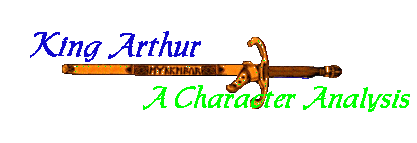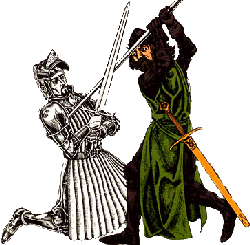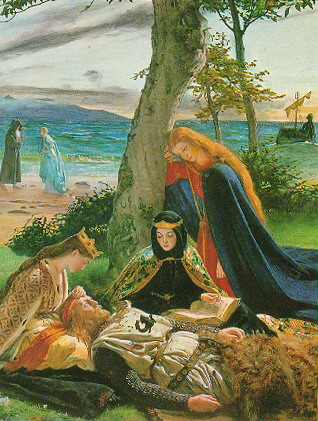



 Arthur as epic hero
Arthur as epic hero Arthur as symbol of the virtues of Camelot
Arthur as symbol of the virtues of Camelot Arthur as Naive Victim of Fate
Arthur as Naive Victim of Fate There is also evidence that Arthur is lost without the advice of the magician Merlin. Arthur does not
always understand the implications of events and is unable to draw his own conclusions without Merlin’s help. The end of
Camelot and of Arthur is caused by Arthur himself without full understanding of his actions. Arthur is
killed by his illegitimate son Mordred whom Arthur fathered in an incestuous relationship with his half-sister Morgan Le Fay.
As is presented in many of the later Arthurian stories, Arthur is duped by Morgan's magical powers, showing his susceptibility
to trickery. In an essay entitled The Case of Sir Mordred by
Tyagi Mordred Nagasive, a case is made for Mordred's not being quite so evil. According to Nagasive, "Mordred might have seen Arthur as weak and indecisive, and himself
as a superior warrior and potential king...Mordred may indeed have had the well-being of the realm in mind when he
attempted to sieze power." Nagasive suggests that Arthur botched the handling of Guinevere’s romance with Lancelot, first
condemning her in a fit of anger and then changing his mind. He sees as one of Arthur's key weaknesses his inability to
balance his love for his wife and Lancelot with his regard for justice: "It is, of course, the inevitable corruption of the hierarchical
power (Arthur's incest with his sister) which begets the doom of the Kingdom, and which prompts the Quest for the Grail." (Nagasive,
The Case of Sir Mordred, Online, 3/23/97)
There is also evidence that Arthur is lost without the advice of the magician Merlin. Arthur does not
always understand the implications of events and is unable to draw his own conclusions without Merlin’s help. The end of
Camelot and of Arthur is caused by Arthur himself without full understanding of his actions. Arthur is
killed by his illegitimate son Mordred whom Arthur fathered in an incestuous relationship with his half-sister Morgan Le Fay.
As is presented in many of the later Arthurian stories, Arthur is duped by Morgan's magical powers, showing his susceptibility
to trickery. In an essay entitled The Case of Sir Mordred by
Tyagi Mordred Nagasive, a case is made for Mordred's not being quite so evil. According to Nagasive, "Mordred might have seen Arthur as weak and indecisive, and himself
as a superior warrior and potential king...Mordred may indeed have had the well-being of the realm in mind when he
attempted to sieze power." Nagasive suggests that Arthur botched the handling of Guinevere’s romance with Lancelot, first
condemning her in a fit of anger and then changing his mind. He sees as one of Arthur's key weaknesses his inability to
balance his love for his wife and Lancelot with his regard for justice: "It is, of course, the inevitable corruption of the hierarchical
power (Arthur's incest with his sister) which begets the doom of the Kingdom, and which prompts the Quest for the Grail." (Nagasive,
The Case of Sir Mordred, Online, 3/23/97)

 According to some Arthurian folklore, Arthur and Merlin are not dead, but sleeping in the blessed isles or in the hollow hills, images that are symbolic representations of the UnderWorld of the Celts. In the following audio file (click here to play), I have presented a monologue (click here for the text version) that the sleeping Arthur might speak upon awakening in the 20th century. Arthur would be confused by today’s culture; however, today's democratic institutions might not seem so unfamiliar. Although an absolute ruler, Arthur had a strong sense of "rule of law," and there is evidence that fair trials were a mainstay of his court.  |
 |